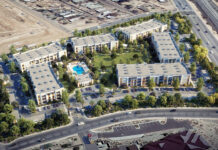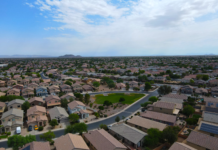
In November 2005 the city of Maricopa started collecting development impact fees. Now a capital improvement plan is in place to regulate the spending of those fees, and infrastructure construction can begin.
Builders are charged development impact fees by the city for the construction of homes or commercial buildings in the city of Maricopa. The fees vary based on the size of the building, but for residential construction the builder is charged a flat fee of $5,346 per home.
Commercial fees vary greatly with a high charge of $10,680 for a shopping center of 25,000 square feet or less and the lowest fee of $1,380 for a manufacturing site. A sliding fee scale encourages larger commercial buildings, which are charged the least amount.
Impact fee revenue is restricted and must be used to finance infrastructure, the basic facilities and installations needed within the city.
Funds are allocated into five different categories:
· Parks
· Libraries
· Public safety
· General government
· Transportation
To date the city has collected nearly $32 million in impact fees but has only spent around $4 million. However, that will soon change as the city plans to spend the remaining $28 during the current fiscal year (July 1, 2008 through July 1, 2009).
Parks
The portion of the impact fee that parks receive is $313 per home build. These fees are to be used for the expansion and building of new parks and the purchase of associated infrastructure.
Of the five areas where impact fees are allocated, parks are the one area that has seen a lot of activity. To date the city has an available $300,000 from development impact fees remaining to spend on these types of projects. In the 2009 fiscal year budget the city plans on spending $2.3 million for the 10-acre Pacana Park expansion, including land acquisition and construction.
Included in this expansion will be two lighted football/soccer fields, 194 parking spots, a playground, maintenance building and future site reserved for restrooms, once funding becomes available. Four shaded areas will also be built on the new fields, and a fence will be erected to keep balls from going onto the adjacent Porter Road.
“These football fields are going to be a great resource for all of the youth and adult football leagues in the city,” said Marty McDonald, Community Services director.
In addition, an outfield fence and lighting will be added to the existing softball field. Money for this project that is not available from the development funds will be transferred from the city’s capital reserve.
Libraries
The portion of the impact fee that goes to the development of libraries is $436 per residential unit. To date the city has not spent any of the development impact fees on library construction.
“With this money you cannot hire staff, so sometimes you have to wait until the money is available in the general fund to hire staff,” McDonald said.
The city will use the majority of the $3.3 million in collected development funds for the construction of a new library. Construction on this new library at Desert Greens Drive and Smith-Enke Road will begin soon, and the city hopes to have the 8,000 square foot facility completed by January or shortly after.
Public Safety
The portion of the impact fees that goes to public safety is $145 per home. These funds are used to expand public safety services, infrastructure and facilities. Since the inception of these fees, the city has collected more than $1 million.
During the 2009 fiscal year the city plans to spend $1.4 million on the purchase of land for a new fire station, radio equipment, a fire brush truck and fire tender vehicle.
General Government
When it comes to the development impact fee pie, the sector defined as general government receives $696 per residential unit built.
General government is all government offices that are not related to public safety. This could be a new city hall, court buildings or other similar structures. Through these fees the city has raised $5,250,000 but has yet to break ground on any new facilities funded through this revenue source.
Those funds will soon be exhausted. The city has plans to build a government complex within the next 10 years, and the first stage of that construction begins this year.
The city has budgeted $6 million this fiscal year to purchase land and prepare it for the construction of this new facility. In addition to the purchase of this new land, the city is also planning on spending $1 million for economic development and $133,000 for information technology infrastructure.
Total spending this year will amount to $7,133,404. In order to offset this cost, the city will transfer $1.1 million from its capital reserve in addition to $835,000 in development impact fees the city expects to bring in through the year.
Transportation
Transportation is the best-funded sector. It receives $3,742 per each new residence built within the city. These funds build and improve roads and are utilized for the construction of other transportation-related infrastructure.
To date, the city has raised $18 million for these projects through the development impact fund, of which $12.5 million is budgeted for this year’s spending.
Some of the major projects included in a long list are:
· Improvements to the Maricopa-Casa Grande Highway
· Improvements to the Honeycutt/Santa Rosa Bridge
· Planning for improvements at Hartman and Farrell Roads
· Signal construction at the intersections of Porter and Smith-Enke Road
· Signal construction at the entrance to the Villages at Smith-Enke Road
The Future
The future of development impact fee collection in the city does not look as bright as it once did.
“At the height of the market we were collecting fees on 600 permits per month; now that number is down to about 100,” said Roger Kolman, director of finance for the city.
Kolman added that the city is collecting more fees from commercial building than in years past. However, the extra fees being generated by the increase in commercial development are not going to equal what the city is losing from the slowdown in new home construction.
To offset that loss in capital, the city is asking voters to approve a $65.5 million bond in November. The bond would pay for two new parks, a recreation center and a new main library.
If approved by voters, the bond would be paid back through the secondary property tax and cost the average citizen $257 a year over the 20-year life of the bond, according to Kolman.
Each of the four areas the bond would finance is considered a separate loan, and the life of each loan is 20 years. Residents would be paying for them until 2034 based on the city’s planned bond issuance.
“This bond, if passed, would allow the city to build capital improvement projects ahead of schedule,” Kolman said.
Development impact fee funds spent to date:
Construction projects:
$1,009,775 Santa Rosa bridge project
$1,000,000 Santa Cruz Bridge project
$107,000 road design
Pacana Park:
$400,000 Pacana Park land acquisition
$525,000 Pacana Park design and construction
$5,992 field equipment Pacana Park field equipment
$3,000 Pacana Park land appraisal
Public Safety:
$455,000 police vehicles
Public Works:
$180,000 street sweeper
$7,500 pickup truck
$13,462 mower
$164,546 dump truck and mower
$3,013 trailer
$33,146 dump truck
$85,362 water truck
$7,458 maintenance vehicle
File photo












![Alleged car thief released without charges Phoenix police stop a stolen vehicle on April 20, 2024. [Facebook]](https://www.inmaricopa.com/wp-content/uploads/2024/04/IMG_5040-218x150.jpg)

![City gave new manager big low-interest home loan City Manager Ben Bitter speaks during a Chamber of Commerce event at Global Water Resources on April 11, 2024. Bitter discussed the current state of economic development in Maricopa, as well as hinting at lowering property tax rates again. [Monica D. Spencer]](https://www.inmaricopa.com/wp-content/uploads/2024/04/spencer-041124-ben-bitter-chamber-property-taxes-web-100x70.jpg)

![3 things to know about the new city budget Vice Mayor Amber Liermann and Councilmember Eric Goettl review parts of the city's 2024 operational budget with Mayor Nancy Smith on April 24, 2024. [Monica D. Spencer]](https://www.inmaricopa.com/wp-content/uploads/2024/04/spencer-042424-preliminary-budget-meeting-web-100x70.jpg)
